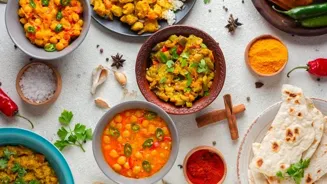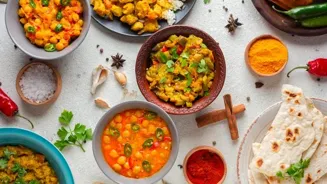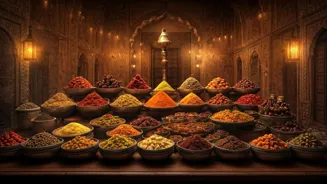Dive into the vibrant world of Indian street food! Explore diverse flavors, cultural ties, and economic impact. Read on to savor this culinary adventure!
India, a land of diverse cultures and traditions,
is also a paradise for food lovers. And when it comes to experiencing the true essence of Indian cuisine, nothing beats the vibrant and tantalizing world of street food.
From the bustling streets of Mumbai to the historical lanes of Delhi, every Indian city has its own unique street food culture, offering a culinary adventure that is both affordable and unforgettable.
Street food is not just about satisfying hunger; it is an integral part of the socio-cultural fabric of Indian cities, reflecting the flavors, history, and traditions of the region.
Street food in India: accessible, affordable, diverse, connecting people through food
One of the primary reasons for the immense popularity of street food in India is its accessibility and affordability. Street food vendors are ubiquitous, setting up their stalls or carts in almost every nook and corner of the city.
This makes delicious and satisfying meals readily available to people from all walks of life, especially those who are on a tight budget. Unlike restaurants, street food joints offer a variety of options at pocket-friendly prices, making it a daily staple for many.
Whether it's a quick breakfast before heading to work, a light lunch during a busy day, or a late-night snack after a movie, street food is always there to cater to your needs.
For students, daily wage earners, and even office-goers, street food provides a convenient and economical way to enjoy a tasty and fulfilling meal without breaking the bank.
This widespread availability and affordability make street food an indispensable part of urban life in India, connecting people from different backgrounds through the shared experience of enjoying delicious food together.
The variety allows a sample of the region's food and not just the well known staples.
Street food in India showcases diverse regional specialties
Street food in India is a microcosm of the country's culinary diversity. Each region boasts its own unique street food specialties, reflecting the local ingredients, flavors, and cooking techniques.
In Delhi, you can find mouthwatering "chole bhature," a spicy chickpea curry served with fried bread, and "aloo tikki," crispy potato patties topped with chutneys and yogurt.
In Mumbai, the "vada pav," a potato fritter served in a bun, and "pani puri," hollow crispy spheres filled with tangy tamarind water and potatoes, are must-try delicacies. Kolkata is famous for its "phuchka," a variant of pani puri, and "jhalmuri," a spicy puffed rice snack.
Down south, in Chennai, you can relish "idli" and "dosa," steamed rice cakes and crispy lentil pancakes, served with sambar and chutney. This incredible variety ensures that there is something for everyone, no matter their taste preferences or dietary restrictions.
From sweet to savory, spicy to mild, the street food of India offers a tantalizing array of flavors that will leave you craving for more, a testament to the diverse ingredients and techniques.
Street food boosts local economies and sustains traditional culinary practices
Beyond its affordability and variety, street food also plays a significant role in promoting local economies. Street food vendors are often small-scale entrepreneurs who rely on their culinary skills to earn a living.
By buying ingredients from local markets and employing local staff, they contribute to the economic growth of their communities. The street food industry provides employment opportunities for a large number of people, particularly those from underprivileged backgrounds.
It allows them to become self-sufficient and support their families. Moreover, street food vendors often source their ingredients from local farmers and producers, creating a direct link between urban consumers and rural communities.
This helps to promote sustainable agriculture and reduce the carbon footprint associated with transporting food over long distances.
By supporting street food vendors, we are not only enjoying delicious food but also contributing to the economic empowerment of local communities and the preservation of traditional culinary practices, offering a valuable connection of livelihoods.
Street food industry in India faces hygiene challenges; govt and public efforts needed
However, the street food industry in India also faces several challenges. One of the biggest concerns is hygiene. Many street food vendors operate in unhygienic conditions, which can lead to foodborne illnesses.
Lack of proper sanitation, improper storage of ingredients, and the use of contaminated water are common problems. To address these issues, the government and local authorities are implementing various measures to improve hygiene standards in the street food industry.
This includes providing training to vendors on food safety and hygiene practices, conducting regular inspections of street food stalls, and promoting the use of safe water and sanitation facilities.
Consumers also have a role to play by being more discerning about where they eat and choosing vendors who maintain good hygiene practices. Awareness campaigns can educate the public about the importance of food safety and hygiene and encourage them to support responsible street food vendors.
The future of Indian street food is promising with support and preservation efforts
Despite the challenges, the future of street food in India looks bright. With growing awareness of food safety and hygiene, and increasing government support, the street food industry is poised for sustainable growth.
Street food is not just a passing fad; it is an integral part of Indian culture and a culinary treasure that needs to be preserved and promoted.
By supporting responsible street food vendors, we can ensure that this vibrant and delicious part of Indian culture continues to thrive for generations to come and that we all can enjoy this culinary heritage. This is one culture that needs to be explored and brought out to the world.
Street food industry evolving with hygiene standards intact
The world of street food is growing everyday and newer innovations are popping up in the cuisine. With growing awareness amongst vendors and customers, the street food industry will ensure hygiene standards and regulations keeping the traditional essence intact.
AI Generated Content. Glance/InMobi shall have no liability for the content











